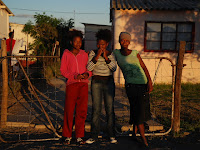


This is Cape of Good Hope. It's about an hour and a half walk from Cape Point; both are on the same peninsula.


This is my host father cutting a cricket bat for his youngest son, Mayeer. They are "Cape Malays," who are mostly originally from Indonesia. They are Muslim, and think they are probably originally from India. He does look really Indian, and they feed us lots of neo-Indian food.

Boulders (Point? Town? Beach?) in Simons Town, between Cape Town and Cape Point. Its famous for its African penguins. They used to be called Jackass penguins, because of their donkey-like braying mating call. Apparently someone decided that a species of penguins in South America also had a donkey-like bray, so the Jackass penguins of South Africa are now merely African penguins. They're pretty funny to watch. You could walk up just a few feet, sometimes less than a foot of some of them nesting. This one gave me a look.




This is an underexposed picture of the Bo Kaap, the area where I'm staying.
Ok, I've been meaning to talk about apartheid, because it's something I really didn't understand before coming here (and to a large extent, still don't understand). So when the Nationalist Party was voted in in 1948, they basically started putting into legislation a set of laws similar to the Jim Crow laws in the South-- segregating races in South Africa. The Nationalist Party was composed completely of whites, and as far as I can tell, Afrikaaners, whites that originated from the Netherlands. Blacks were prevented from voting of course (for if they could vote, they would vote out the Nationalist party-- Blacks compose about 80% of the population). Blacks were also forced into townships, like Zwelethemba (see previous entry), which were basically shantytowns outside of major towns/cities. The City of Cape Town was thus almost completely white, and "Coloureds" (not Black or White, this included the Cape Malay population from Indonesia and South Asia) were forced into segregated districts such as Bo Kaapand Coloured townships, not too different from the Black townships. Bo Kaap is a Muslim neighborhood in the hills overlooking the city, separated from the center where whites were allowed. Whites were allowed to live in the city and suburbs. By separating these different non-white populations, the NP created a system in which there was little solidarity among these oppressed groups.
Even today, many "Blacks" and "Coloureds" and "Whites" hold resentment against other racial groups. Conquer and Divide, just like the British in India. Even today, with the end of the apartheid regime in 1994, the effects of segregating populations is still felt in all parts of South Africa.


Your humble correspondent,







































